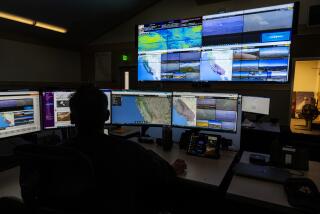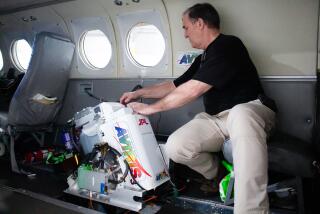Trio of NASA craft will boost climate data
Reporting from Washington — NASA heads into 2010 with the bittersweet assignment of retiring the space shuttle after nearly three decades. But the agency also plans to launch three new satellites aimed at better understanding the sun and Earth’s climate and oceans.
Two satellites will examine Earth -- specifically, the concentration of salt in the world’s oceans and the presence of aerosols, or minute particles, such as dust or ash, in the atmosphere. A third satellite mission will study the sun and its effect on space weather, including solar flares that can disrupt communication on Earth.
All three come at a critical time for NASA. Data will probably influence global-warming research, and the launches could serve as bright spots in a year otherwise dominated by debate over the future of the manned space program.
The two Earth probes “are extraordinarily timely,” said Michael Freilich, head of NASA’s Earth-science division. “It is a quest for understanding of the Earth system and [to improve] our ability to predict how our wonderful environment and our planet is going to change in the future.”
Details of the three missions, which will cost more than $1.5 billion:
Solar Dynamics Observatory
* Launch: Feb. 3 from Cape Canaveral Air Force Station.
* Cost: $844 million.
* Overseen by: Goddard Space Flight Center in Maryland.
* Mission: Study the solar atmosphere and the sun’s effect on space weather and Earth.
* Duration: At least five years.
Predicting weather in space can be tricky. Scientists hope this satellite can help astronomers better anticipate the solar flares, sunspots and magnetic storms that can jeopardize electrical communications on Earth as well as astronauts in space.
The Solar Dynamics Observatory will carry three instruments to document solar activity: a high-speed camera, a device to record the sun’s ultraviolet brightness and an imager that uses sound waves to map the sun’s interior -- similar to the way an ultrasound produces fetal images.
The aim is to better understand the sun’s magnetic field, which influences the development of sunspots, solar flares and magnetic storms, called coronal mass ejections. That should improve forecasting of solar eruptions, in much the same way that hurricane forecasters use broad climate conditions to estimate the number of storms each season.
The key is learning more about the solar cycle, which every 11 years or so flips the star’s magnetic pole from north to south, or back again. This change triggers intense solar activity and blasts cosmic rays toward Earth that can disrupt cellphones and cause widespread blackouts.
“The sun hasn’t changed very much. But human technology has. So it’s more important to understand the sources of the ways these changes affect Earth,” said Barbara Thompson, the mission’s deputy project scientist.
Aquarius
* Launch: Undetermined date in 2010 from Vandenberg Air Force Base in California.
* Cost: NASA will contribute $273 million to the joint mission with Argentina.
* Overseen by: Jet Propulsion Laboratory in La Cañada Flintridge
* Duration: At least three years.
* Mission: Provide global measurements of saline levels in seawater and how that relates to Earth’s water cycle.
For the past 100 years, scientists have relied on ships and buoys to estimate how salt is distributed throughout the oceans. The readings were incomplete, however, and didn’t provide timely readings of changes in salinity.
Using three onboard radiometers that can detect small changes in salt levels, Aquarius will enable scientists to build a global map of sea-surface salinity and track how salt moves through ocean currents.
The data could be critical in learning how ocean circulation and weather patterns such as El Niño respond to global warming.
Variations in salt levels generally result from fluctuations in rainfall and evaporation, said Gary Lagerloef, the project’s principal investigator.
For instance, the readings could give oceanographers a better idea of how fresh water from melting polar ice caps is distributed globally.
Glory
* Launch: Oct. 9 from Vandenberg Air Force Base.
* Cost: $419 million.
* Overseen by: Goddard Space Flight Center.
* Duration: At least three years.
* Mission: Observe the effects of aerosols on the Earth’s climate.
One of the big questions in global-warming research is the effect of aerosols -- soot, smog, auto exhaust, factory chimneys, volcanic eruptions and myriad other sources -- on Earth’s temperature.
Aerosols can influence climate by reflecting or absorbing the sun’s radiation. Some aerosols might counteract the effects of greenhouse warming by deflecting some of the sun’s rays.
Scientists believe that aerosols from major volcanic eruptions, for instance, can temporarily lower temperatures by reducing the amount of solar radiation reaching Earth’s surface. But scientists have been unable to accurately measure the influence of aerosols. Climatologists believe black-carbon aerosols -- such as soot -- absorb the sun’s heat, rather than reflect it, resulting in a warmer Earth.
Glory will try to catalog the different types of aerosols in the atmosphere. Understanding the composition could help scientists better evaluate aerosols’ net effect on the climate.
“We know that aerosols are having a significant effect, but we don’t know the magnitude of that effect,” said Michael Mishchenko, the project’s chief scientist.
mmatthews@
orlandosentinel.com






